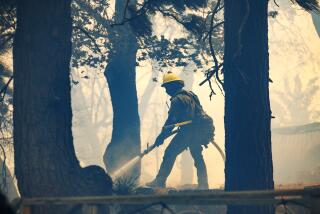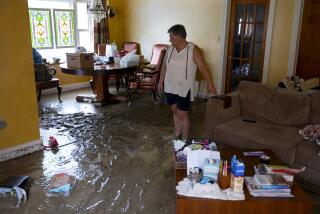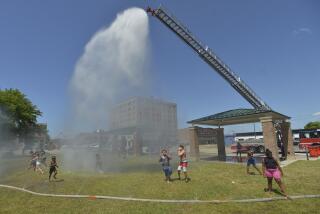Forget the Blizzard of 1978; Buffalo remembers Blizzard of 1977
If you hail from the nation’s snow country, wintry blizzards are like some bully you endured back in grade school: You never forget them, and their long-ago tortures grow in size and scope with each retelling.
As a storm of possibly historic magnitude slams the East Coast this weekend, my thoughts are blown back to the worst winter tempest of my life, in upstate New York, with the strange, tragic and even funny memories it left behind for those who endured it. The recollections haven’t become overblown with time. The storm really was that bad.
So here’s a yarn about one hopeless battle with Old Man Winter at his angriest. Light a hearth fire and grab a blanket -- and by all means feel free to share your own snowbound stories. Consider it our little therapy group.
PHOTOS: Winter storm blasts Northeast
The weekend’s storm has prompted many comparisons to the Blizzard of 1978. But in working-class Buffalo, nobody talks about 1978. For them, the Mother of All Storms came earlier, that cruel January ambush known as the Blizzard of ’77, with its icy fangs gnashing, its breath frozen.
It was a so-called perfect storm, a once-in-a-generation weather system combining an unlikely compilation of high winds, avalanches of snow and frigid temperatures. And, of course, if you were there, it was far, far from perfect. It was terrifying. In the end, 29 people died.
Cities like Buffalo endure “lake effect” storms: systems that move across Lake Erie, picking up moisture, only to dump their snowy load at landfall. The result is an almost cartoonish amount of snow and, in this case, civic paralysis.
The flurries began Friday, Jan. 28, and continued for days. All across the western New York-Southern Ontario region, winds of up to 70 mph eventually created drifts that swallowed houses.
Powdery flakes pummeled the city so fast the snow plows (and these folks are the most experienced snow movers in the nation) couldn’t keep up. The white stuff blanketed even major arteries. Stranded drivers left their vehicles and scrambled for warmth and cover.
At one point, officials estimated that 1 out of every 5 cars in the city was either illegally parked or abandoned. Snowmobiles became the only mode of transportation.
Electrical outages and shortages of natural gas caused the entire city to simply shut down.
Back then, my brother-in-law, Neil Downey, worked for the local power company, then called Niagara Mohawk. Around noon, he was atop a bulldozer, smoothing the frozen turf outside a power substation. At one point, he looked up at the lowering western skies and said, “What the hell is that?”
The storm was upon them. The bosses commanded all the utility workers to stay on the job for the foreseeable future. Neil got an assignment to venture out into the weather and scout out some grub for his hungry colleagues.
His best friend, Vinnie Mineo, happened to own a pizzeria, which was one of the last businesses to remain open. (“Are you kiddin’ me,” Neil says. “The guy never closed.”) In a pickup truck, with radio in hand, it took him 90 minutes to traverse a normally 10-minute drive.
And it’s funny what you remember: Neil recalls one beefy utility linemen, later huddled under an office desk with an entire pizza. “He was a pig; he wanted to make sure he got his share.”
Soon, police banned all vehicular traffic; not that anyone could move anyway.
At the time, Neil and Vinnie co-owned a corner shop called My Liquor Store. During the storm, a cop stopped Vinnie on his way into work. Vinnie begged him, saying he had to ignore the travel ban and open his store; he’d go broke if he didn’t.
Two days later, people wandering along the streets looking for food, drink and just something do to had bought up the shop’s entire liquor supply. There wasn’t a bottle left on the shelves. Everything was gone, including a dusty decrepit bottle of cheap booze called Five Star Whiskey, which had been there, forsaken by shoppers, for years.
Vinnie, who has since fled Buffalo for warmer climes in Mesa, Ariz., recalls that his uncle, Paul Tripi, had died days before and, on the afternoon the storm hit, he was on his way to the viewing. “I never made it,” he says. “The snow started and it didn’t stop.”
Vinnie says his uncle wasn’t buried until spring -- there was just too much snow. And anyway, officials used the cemeteries as storage lots for all the cars they towed off the streets. “I never saw my uncle again,” Vinnie says. “The undertaker put him on ice until spring came.”
By Tuesday, Buffalo Mayor Stanley Makowski declared a state of emergency. Ignoring the ban on non-essential travel brought fines up to $500 and 90 days in jail. Still, scores of people got ticketed.
Slowly, over the coming days, Buffalo began to dig out. On Wednesday, the first mail delivery since the storm hit came via six four-wheel drive trucks hauled in from nearby Rochester.
I was a lightweight. On Friday, sensing the oncoming maelstrom, I caught the last Greyhound bus out of Buffalo back home to Syracuse. I couldn’t return for another week, as my fellow students at the State University of New York at Buffalo got a frolicking, unscheduled “Let’s make some goofy snowmen” break from classes.
Makowski brought in mammoth Army Corps of Engineer earthmovers to clear city streets of the by-then dirty snow. But they could plow out only a lane and a half on most thoroughfares, so by spring, many cars were missing driver’s side mirrors, most of them having been sheared off by passing buses.
Buffalo eventually recovered. When they talk about that winter, people still tell stories about where they were when the brunt of the storm hit; where they left their car, and what motel or restaurant gave them refuge. It even moved one man to song, as the video above shows.
Still, this is a no-nonsense crowd. Buffalonians don’t fear snow. Bring it on, they say. Like Neil, my brother-in-law. He’s a tough guy.
“We expect snow here,” he said. “The plows come in -- a couple a days we’re back on the road.”
ALSO:
Naming a winter storm? Meteorologists appalled by ‘Nemo’
In FBI files, clues about photographer’s work as an informant
Bush family emails hacked: ‘can happen to anyone,’ expert says
More to Read
Sign up for Essential California
The most important California stories and recommendations in your inbox every morning.
You may occasionally receive promotional content from the Los Angeles Times.










